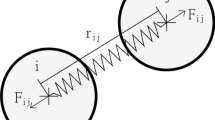Abstract
The dynamical systems approach to sizing and SIMP topology optimization, introduced in a previous paper, is extended to the case of time-varying loads. A general dynamical system, satisfying a Lyaponov-type descent condition, is derived and specialized to a goal function combining stiffness and mass. For a cyclic time-dependent load it is indicated how, in the limit of short cycles compared to the overall time scale, this can be handled by multiple load cases. Numerical examples, both for a convex and a non-convex case, illustrates the theory.



Similar content being viewed by others
Notes
The acronym SIMP stands for Solid Isotropic Material with Penalization and is essentially an approach for penalizing intermediate design variable values when optimizing stiffness under a volume constraint (or the reversed). For a detail account we refer to Bendsøe and Sigmund (2003) and Christensen and Klarbring (2009).
In the generalized version of bone remodeling theory, presented by Harrigan and Hamilton (1994a), q = N/m, where N is the exponent of the stiffness relation, m is a positive constant and \(\rho^{1/m}_i\) is the apparent density.
References
Achtziger W, Bendsøe MP, Taylor JE (1998) Bounds on the effect of progressive structural degradation. J Mech Phys Solids 46(6):1055–1087
Bendsøe MP, Sigmund O (2003) Topology optimization: theory, methods and applications. Springer, Berlin
Christensen PW, Klarbring A (2009). An introduction to structural optimization. Springer, Berlin
Dunlop JWC, Hartmann MA, Bréchet YJ, Fratzl P, Weinkamer R (2009) New suggestions for the mechanical control of bone remodeling. Calcif Tissue Int 85:45–54
Harrigan TP, Hamilton JJ (1992) Optimality conditions for finite element simulation of adaptive bone remodeling. Int J Solids Struct 29(23):2897–2906
Harrigan TP, Hamilton JJ (1994a) Necessary and sufficient conditions for global stability and uniqueness in finite element simulations of adaptive bone remodeling. Int J Solids Struct 31(1):97–107
Harrigan TP, Hamilton JJ (1994b) Bone remodeling and structural optimization. J Biomech 27(3):323–328
Jang G, Kim Y, Kwak BM (2009) Analogy of strain energy density based bone-remodeling algorithm and structural optimization. J Biomech Eng 131:011012
Klarbring A (2009) Topology optimization, dynamical systems, thermodynamics and growth. In: Damkilde L, Andersen L, Kristensen AS, Lund E (eds) Proceedings of the twenty second nordic seminar on computational mechanics, Aalborg, pp 337–344
Klarbring A, Torstenfelt B (2010) Dynamical systems and topology optimization. Struct Multidisc Optim 42(2):179–192
Klarbring A, Petersson J, Torstenfelt B, Karlsson M (2003) Topology optimization of flow networks. Comput Methods Appl Mech Eng 192:3909–3932
Rockafellar RT (1972) Convex analysis. Princeton University Press, Princeton
Rozvany GIN, Querin OM, Gaspar Z, Pomezanski V (2002) Extended optimality in topology design. Struct Multidisc Optim 24:257–261
Rozvany GIN, Querin OM, Gaspar Z, Pomezanski V (2005) Erratum for the brief note “Extended optimality in topology design” by GIN Rozvany, OM Querin, Z Gaspar, V Pomezanski (SMO 24:257–261, 2002). Struct Multidisc Optim 30(6):504
Sigmund O (2007) Morphology-based black and white filters for topology optimization. Struct Multidisc Optim 33:401–424
Stolpe M, Svanberg K (2001) An alternative interpolation scheme for minimum compliance topology optimization. Struct Multidisc Optim 22(2):116–124
Strömberg N (1997) An augmented Lagrangian method for fretting problems. Eur J Mech A, Solids 16:573–593
Strömberg N (2010) Topology optimization of structures with manufacturing and unilateral contact constraints by minimizing an adjustable compliance-volume product. Struct Multidisc Optim 42(3):341–350
Taylor JE, Bendsøe MP (2001) A mutal energy formulation for optimal structural design. Struct Multidisc Optim 22(2):95–101
Xie YM, Steven GP (1997) Evolutionary structural optimization. Springer, Berlin, pp 95–101
Author information
Authors and Affiliations
Corresponding author
Rights and permissions
About this article
Cite this article
Klarbring, A., Torstenfelt, B. Dynamical systems, SIMP, bone remodeling and time dependent loads. Struct Multidisc Optim 45, 359–366 (2012). https://doi.org/10.1007/s00158-011-0724-x
Received:
Revised:
Accepted:
Published:
Issue Date:
DOI: https://doi.org/10.1007/s00158-011-0724-x




